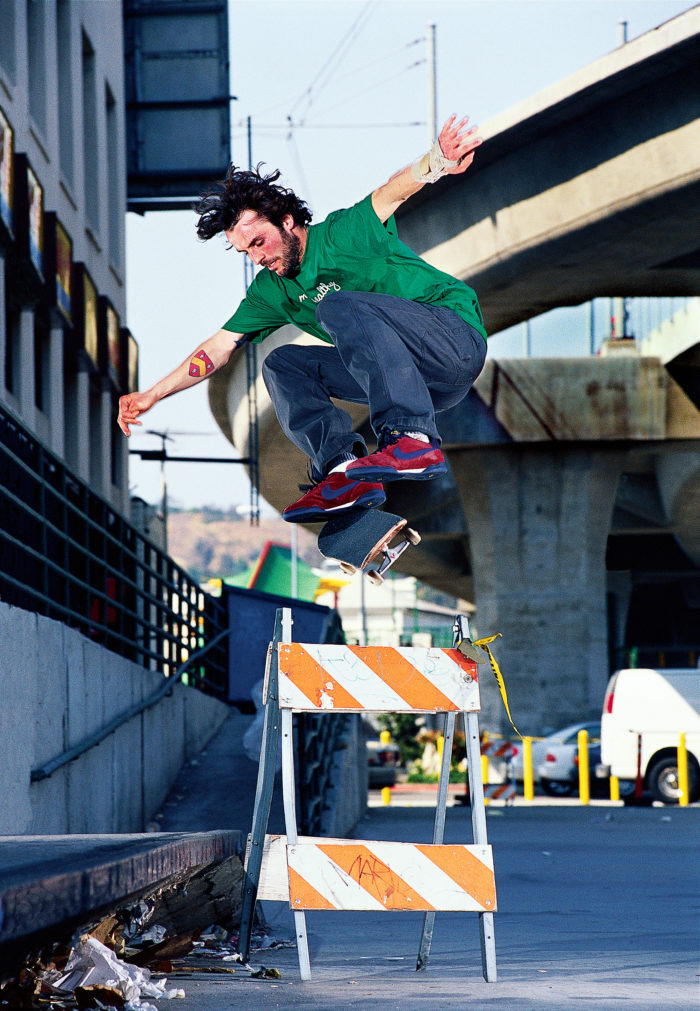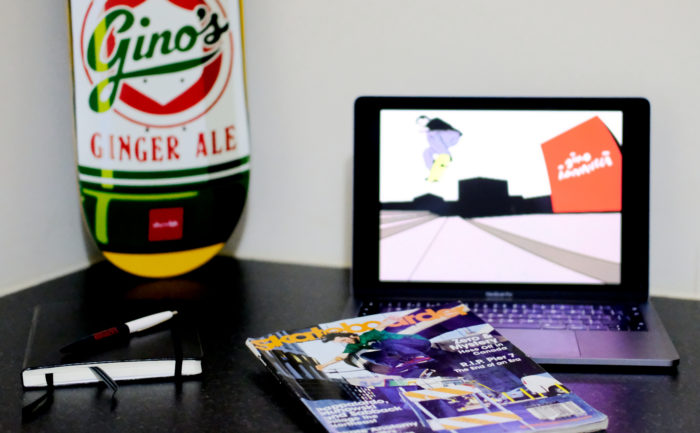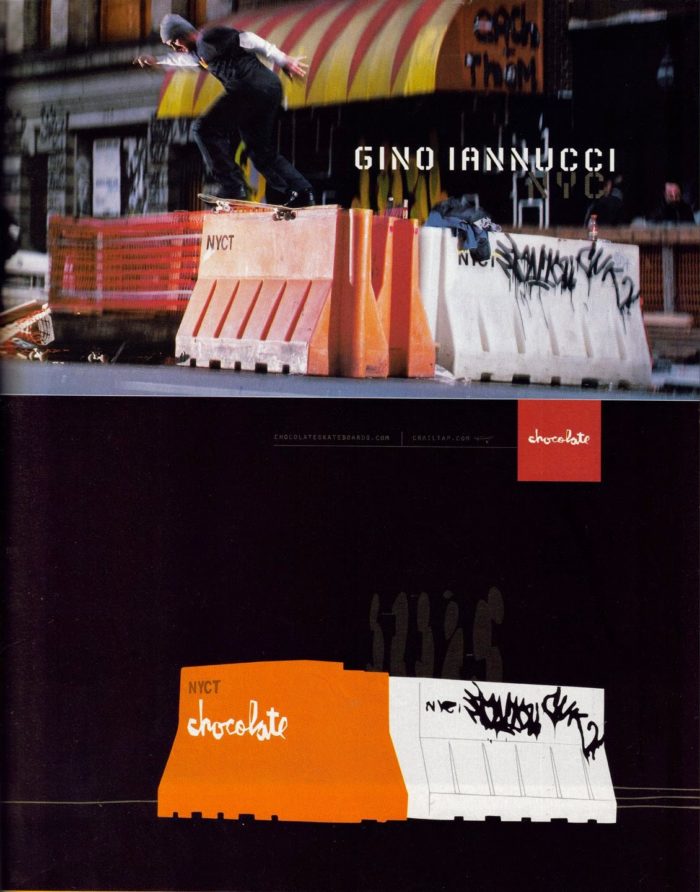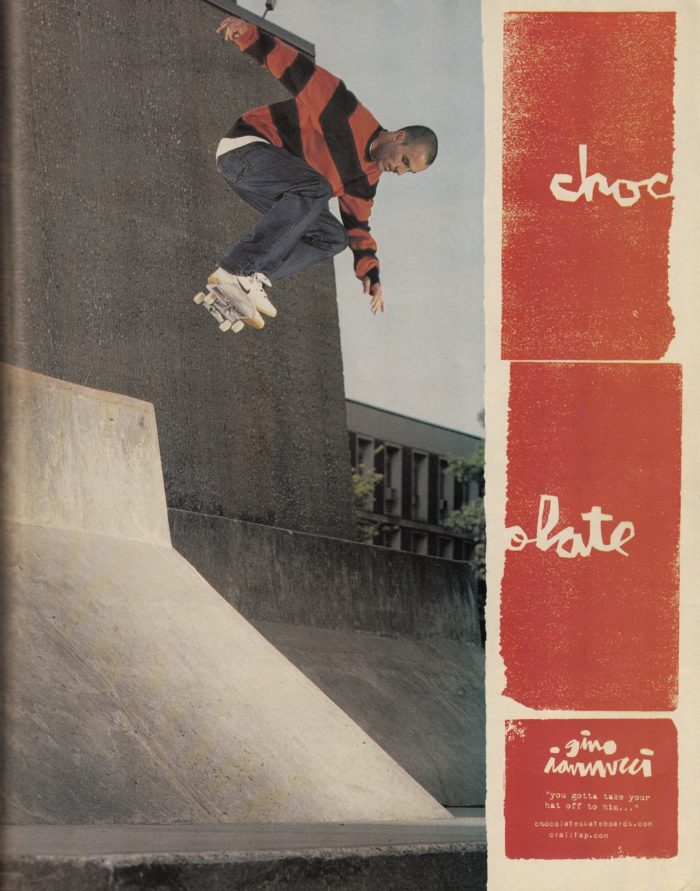Photographer Ben Colen reminisces about a day in Los Angeles shooting with Gino Iannucci which lead to his first Skateboarder Magazine cover and his time with the publication.
Gino Iannucci by Ben Colen – switch kickflip, Los Angeles published in Skateboarder Magazine, Volume 14 Issue 3, November 2004. Interview by Farran Golding.
“Every man has his techniques and they’re all different. And when you know mine, you’ll be dead.”
soundbite from the introduction to Gino Iannucci’s Trilogy part
After a few years of flying west for the winter, photographer Ben Colen moved to L.A. in 2002 to better suit his staff position at Skateboarder Magazine.
Back then, shooting with strangers was fairly common. “Somebody at the mag would say, “We need a photo of so-and-so, can you hit them up?” and I would go out with somebody I maybe didn’t even know,” Ben recalls. “Working for a magazine was different in terms of, when I did that, there was almost a ‘cold call’ thing you had to do sometimes.”
One morning, however, Ben found himself on the receiving end of a call from a number he didn’t recognise. He answered and was met with a familiar Long Island accent belonging to one Gino Iannucci…
On the other side of the Atlantic, some 15 years later, I answered my phone and was met with the familiar voice of one Jake Sawyer. As our conversation turned to the subject of memorable skate photos, an issue of Skateboarder Magazine came to mind. The issue in question featured Gino on the cover, switch kickflipping over a striped orange and white A-shaped board from a bump down some L.A. back alley. “Do you know the one?” I asked Jake. “Is he wearing a green shirt?” he replied.
As prominent as it is, Gino’s green t-shirt is actually the least noteworthy aspect of this photo for me. The height of the switch flip and clearance over the obstacle, the nonchalant posture and slight angle of Gino’s back foot on the catch, the family crest emblazoned on his arm which subtly colour matches his Barcelona FCs, the typically skinny mid-2000s board, the shaggy hair – a contrast to Gino’s usual neat trim… I’d have pictured any of those things first but Jake honing in on that green Mighty Healthy tee was enough to convince me this photo had the staying power to justify delving a little further.
Promptly, I got in touch with Ben to talk about the photo at hand. It’s unclear exactly why Gino hit Ben up on that particular day, but after they got off the phone he was left thinking, “Oh shit, I’m going to shoot a photo with Gino Iannucci…” and by the end of the day, Ben had his first magazine cover waiting to go.
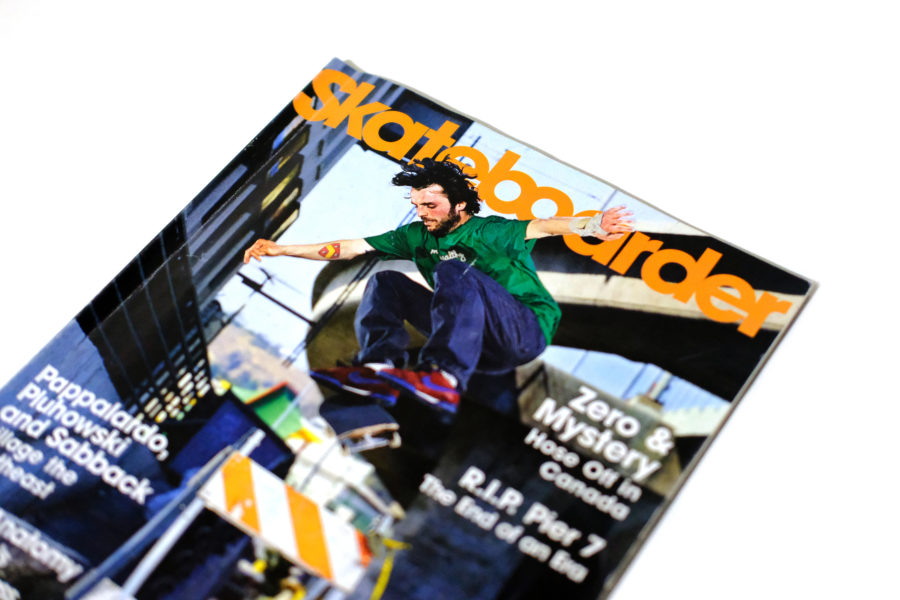
We’ve got Long Islanders on both sides of the camera here. I’m not too sure about the age gap between you guys, but did you see Gino around before either of you moved away from New York?
No, I didn’t actually. He’s a couple of years older than me but I never met him on Long Island other than seeing a glimpse of the dude here or there. Growing up, I wasn’t skating with pros or anything, I just skated with my friends. Long Island is big. I had friends from different towns, and we’d all meet up and skate; you’d have your crew but even if we went into the city it didn’t necessarily mean we’d run into other crews. Obviously, everybody knew who Gino was, I just didn’t see him back then. I might not have moved to L.A. yet, but I was coming out in the winter, from Boston, to shoot photos. I started skating with the Girl dudes and I think that’s when I met him – around 2002 or 2003.
What’s your earliest memory of skating with Gino?
I definitely met him within a year of whenever we shot that switch flip. That might have been the first thing we shot but there was also a day at 7th Street where he was trying a trick for a while, and a bunch of people were skating, and I might have met him around then. But basically, I would have met him in like 2002/2003 and I remember being somewhat starstruck at the time just because it’s Gino. I’d been taking skate photos for a while, I guess I’d been doing it for six years or something at that point, but it was still kind of a new thing and meeting people was always exciting on some level.
You moved to L.A. to work for Skateboarder Magazine but, if I’ve got my facts straight, Gino was living back in New York during the Yeah Right! years. This cover ran in late 2004. I don’t know if he was still on the East Coast but how did you two find yourself together in L.A. on this day?
I was trying to think about when we actually shot it because it got put on ice for a while. I’m pretty sure he hit me up and, at that point, I had definitely met him before. We hadn’t hung out much, but I’d met him. He must have gotten my number from Aaron Meza [then editor of Skateboarder Magazine]. He hit me up because he was going to try and film something with Ty [Evans] and wanted to go shoot a photo and of course I was down [laughs].
“I was so stoked. Especially because he’s the Long Island ‘hometown hero’”
So, although this was published post-Yeah Right! it could have been shot during the filming of it?
It might have been shot after Yeah Right! came out. That was my first cover. When I shot it and brought it to Skateboarder, they said, “ That could be a sick cover,” but it had to wait because there was a bunch of other stuff in between. The way magazines worked back then; you would wait a while. You shot it and it might take six months to come out.
We might have shot it at the end of 2003, or even early 2004. It’s funny, actually, Gino hit me up to ask if I could send it to Chocolate because he needed an ad. I had to tell him, “They might want to use it for a cover, so I don’t know if you want to hang on?” and he was like, “Fuck it, hold on to it then.” I was so stoked. Especially because he’s the Long Island ‘hometown hero’ or whatever. It was pretty exciting.
Where’s this spot and what lead you there? Although he was filming with Ty, it doesn’t seem like something somebody would go out of their way to skate. If anything, it looks like one of those spots you’d catch out of the corner of your eye, on the way to somewhere else, and think, “Oh, that looks fun. Let’s skate here for a little bit.”
Well, what’s funny is it’s a spot you’ll have seen a million times in videos back then. It’s this metal edge ledge in Chinatown. I think [Mike] Carrol had a backside smith back 360 there and Scott [Johnston] had a really good line that was in Fully Flared or something. It was this long metal ledge, that people mostly skated as a pop-out ledge, but there was also that sort of shitty bump right there that people would fuck with sometimes. I don’t remember there being too much [documented] with people skating the bump before that. Later on, I think I shot Jeremy Wray doing a trick off that as a bump too. But basically, it was a ledge. At the time, it was a pretty hot spot because it was one of those where it would take a while to get kicked out and in L.A. those are pretty rare.
“It’s not like Gino talks much anyway and when you’re shooting with somebody for the first time, you don’t always know what they want to hear. Some people want you to be encouraging, some people don’t want you to say anything.”
Was anyone else around?
No, it was just me, Gino and Ty. Honestly, I probably didn’t say that much. It’s not like Gino talks much anyway and when you’re shooting with somebody for the first time, you don’t always know what they want to hear. Some people want you to be encouraging, some people don’t want you to say anything, so I don’t know how much I talked that day, necessarily.
It’s interesting that he hit you up out the blue because I’ve read Gino talk about being uncomfortable with his own company, let alone around people he doesn’t know too well.
Yeah, it’s been a long time but maybe he just needed an ad and he got my number from Meza. Or, Meza could have even been like, “Try to get something for the mag,” or whatever. That’s the only way I can assume it happened.
At what point did you decide to pull the camera out?
He definitely hit me up with an idea in mind. I think he went there specifically with the idea of switch flipping that board. I’m sure we probably just messed around until he wanted to try it but when he set the thing up, I knew what he was trying to do.
Did Gino come down the alleyway and weave in or roll from that slope in the back-left of the photo?
I’m not 100% but I picture him skating from the sidewalk more than coming down that handicap ramp. People would skate down the handicap ramp, but it wasn’t as awkward as it maybe looks in this photo because I’m shooting from straight ahead. It’s not a severe cut-in so I feel like if you were going to skate the bump you would skate it from the sidewalk. It was probably easier than having to start at the top of that handicap ramp.
How much kick did that bump actually have to it?
I’d say it’s shittier than it might look [laughs]. It was okay, it’s definitely not one of those bumps that really blasts you. It wasn’t one of those ski-jump things that really kicks, it was one of those fake-out bumps, maybe. Fine, but not incredible.
One of those where it’s a bit more psychological. You convince yourself you can pop higher because you’ve got a ‘ramp’.
Yeah, exactly, it’s not the most amazing bump but he obviously made it work.
“It was like he wasn’t going to bother landing it if he wasn’t going to do it perfectly.”
It goes without saying that Gino’s effortlessness adds to the mystique. Still, the majority of us have only been exposed to him in videos so, for the most part, we’ve just seen the makes which are flawless. However, does seeing Gino skate first-hand make that aspect of his style even more impressive? In that; you get to see him try and try and try, then when he lands it doesn’t look like he had to try at all?
It’s awesome to see him skate in person. For one thing, because he skates really fast and… It’s hard to explain but it always looked like when he was trying to do something he would fall off his board – not eating shit – but it was like he wasn’t going to bother landing it if he wasn’t going to do it perfectly.
If it was slightly off balance, he would just let the board go or kind of lean back and fall off. Like, “Fuck it.” He wasn’t going to fight it. That’s the way it always looked to me. He’d just keep trying it and when it was going to happen, it was because that one was going to be perfect.
There’s almost a supernatural quality to that. Not working for the make, per se, but just deciding which one is worth committing to.
Something like that. It’s that thing where you see people do a trick and they’re obviously hanging on or forcing it, like, “I’m going to fucking land this thing.” With him it was just, “Oh, the board shot out.” Fall back. “Whatever.” Then all of a sudden, it’s bolts. That’s how I picture it, I might be oversimplifying but from an outsider’s perspective that’s how it always looked to me.
It’s a real nondescript spot and getting something golden out of it pretty symptomatic of Gino. Personally, how important is the person in front of the camera and how would you say their personality comes into play with making a photo great?
With skate photography it’s a huge, huge part of it. You can’t think of bad photos of certain people, right? And that’s not necessarily because the photographer fucking nails it every time. It’s all about the skater, really. Of course, everything else goes into it but there are people that you’re going to see a photo of, it might be super gnarly, but it’s kind of just, “Oh, that’s gnarly!” and then you forget about it.
Then there are certain people who can have a photo doing very little but it’s fucking amazing because of how that person does things. To me, it seems like a pretty obvious thing about skateboarding. It’s like Mark Gonzales, you can see a photo of him doing nearly fucking anything and it looks incredible but that definitely wouldn’t work for some people.
That leads into my next question, actually. Magazine covers were generally quite hammer heavy at this point. For instance, the cover of Skateboarder the month after this issue was Andrew Reynolds kickflipping a hefty four-block. So, do you think this cover was a bit of outlier for where skateboarding was at back then?
I don’t know how much of an ‘outlier’ it was because it’s still Gino and it’s a good switch flip. I remember being hyped that he’s pretty big in the frame for the cover. You know a lot of the time when you see the dude on the cover and he’s small because the spot is so big? I thought that this looked different because he’s filling so much of the frame. I don’t know how much that was or wasn’t different than what was going on at the time but, to me, it seemed a little different.
What other memories does this photo bring back about the time period?
Like I said, it was my first cover so that was definitely a big deal. I had been shooting a while and always wanted to shoot a cover. I don’t know how much beyond that. I spent a lot of time at that spot, for sure. Like I said, it was a go-to and one of those things that you wouldn’t get kicked out of. A good amount of my time was spent hanging out at those kinds of spots. Other than that, I guess with working for the magazine I definitely ended up on more random sessions back then than I would now. That part of it stands out.
I imagine if you were getting dragged to this thing on the regs, for people to skate it as a ledge, it would have been refreshing for someone to skate it this way.
For sure, because I’m not sitting there shooting a sequence of a ledge trick forever. That might be the first still I shot at that place, before that I was just sitting there shooting sequences for days.
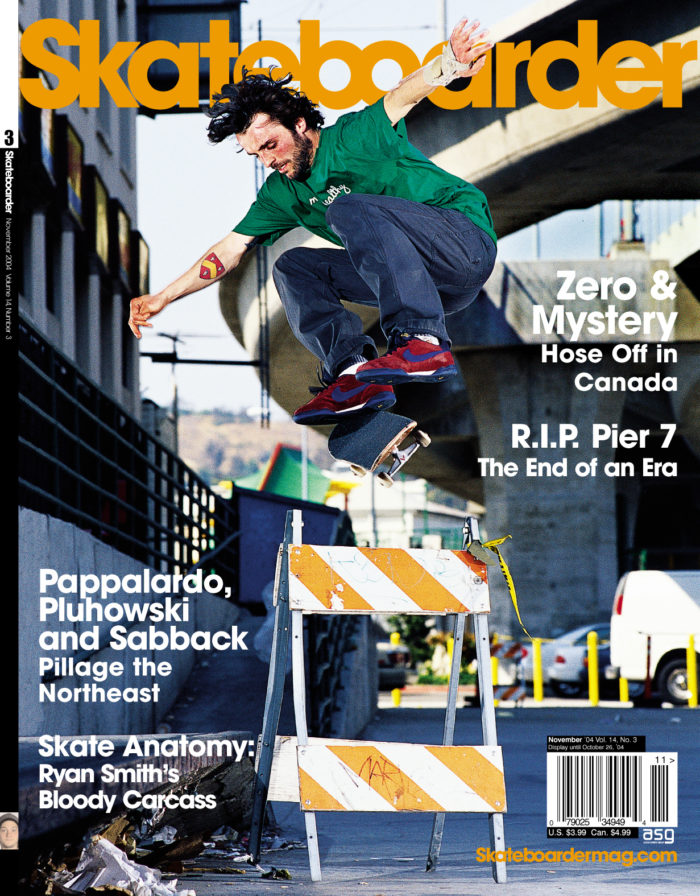
Gino Iannucci by Ben Colen for Skateboarder Magazine Vol. 4 #3, November 2004 courtesy of Jaime Owens
Let’s go back a little further, how did you become involved with Skateboarder in the first place?
I was living in Boston and I started contributing right when they started [this incarnation – Skateboarder had an original short run from 1964 to 1965, came into prominence from ’75 to ’83, then resurfaced in ’97 until ceasing in 2013 – ed.].
They had these two annual issues that came out of nowhere then they started the mag again. Actually, Giovanni Reda told me he was going to work for them in the beginning. “Yo, they’re going to start Skateboarder up again, just start sending them photos,” so I started sending photos in right away.
I would go with my friends from Boston to California in the winter, probably from ’98/’99, and try to shoot out there for a while. We’d meet other people and then when Skateboarder started the editor was this dude called Sean Mortimer who I didn’t really know or have any kind of relationship with. But when Aaron Meza took over, I talked to him once or twice and we just hit it off right away. When I’d come out [to L.A.] I would meet up with him and he would introduce me to people. That was the whole genesis of it.
So, you started out as a contributor before getting a staff position? Because you’re down as an associate editor when this ran.
Well, technically I got on staff in 2000 but I didn’t move to L.A. until 2002. I was doing it from Boston and travelling, I would go back and forth, but Aaron was always trying to get me to come over because there was a lot going on out here. That’s how I ended up moving here, eventually.
Brian Gaberman is also listed as an associate editor. I’m guessing you guys were essentially staff photographers who occasionally got tasked with writing.
Yeah, the ‘associate editor’ thing… Honestly, when I was first out there, the staff was me and Reda until he left at some point. Mike O’Meally and Oliver Barton were both the main dudes there, then they split to go to TransWorld so I got bumped up and Gaberman probably got bumped up at that time too. It was really just a way of becoming an employee rather than just being on retainer. I don’t remember having much of an editorial responsibility [laughs].
“Meza was a real critical editor to the point where, as a photographer, it could be frustrating at times … but it made for a really good magazine that was always cool to look at.”
The Skateboard Mag started in 2004. Did having another magazine around change anything about the publishing landscape in the States?
I don’t remember feeling particularly competitive about it or anything like that. I remember it being a big deal that those dudes were leaving [TransWorld] to start their own thing, for sure, but not in the sense of, “Oh shit, this is going to be a problem,” you know? In retrospect, it’s a bummer that more of these things didn’t last. There could have been people in ad sales who were tripping on it but from my side of things, I just had more pictures to look at [laughs].
Personally, what differentiated Skateboarder from the other three major US mags?
Generally, I always thought the photography was really good. I’m not talking about myself but when they had Oliver and O’Meally, Gaberman and Jon Mehring and Joey Shigeo; there was a lot of really good photographers working there.
Meza was a real critical editor to the point where, as a photographer, it could be frustrating at times [laughs]. I’d think a photo was sick and he’d be like, “Ah, I don’t know,” but it made for a really good magazine that was always cool to look at. I was excited to be working somewhere with a bunch of people who I was hyped on as a photographer.
Course you guys are friends but with Meza being so professionally cutthroat, shall we say, did that provide a bigger sense of accomplishment when something would get run, let alone make it to the cover?
Yeah, definitely. Like I said, it could be frustrating. If you’re the person shooting the photo then you want to see it get run but if it did it felt like, “Okay, it’s got to be alright.” Even after Aaron left to go back to Girl, and Jaime Owens took over, Jaime had been working under Aaron for so long that he continued in the same way where he would definitely be critical of what he would put out there. I feel that stands out. I’m sure every magazine is like that but that’s the one I worked for so that’s the one I have the biggest impression of.
I’m sure there are myriad answers to this but, for you, what’s the main thing that’s changed about working as a skateboarding photographer over the last 15 years?
There are way fewer outlets, at least in my mind. It’s hard to get photos run because now, in the U.S., you have Thrasher as a print mag and that’s pretty much it. At one point there was four magazines, and I worked for one of them, but when I was at Girl there was all these different outlets for photos so if they weren’t using them, I could use it for this, this, this or this. There’s a lot less of that now so I feel it’s just harder to get photos run and a lot of the time you shoot photos knowing they’re just going to end up on Instagram.
There’s a paradox now. The gatekeeping role of magazines has been removed, it’s harder to have something published, while simultaneously it’s easier to put your photos out there for anyone to see. If that makes sense…
Yeah, maybe to rephrase it: you can get your photos out now, for sure, but you might not get paid for it, which you did back then. Even if it wasn’t much, you’d be getting paid something. If you’re a photographer, especially my age; I still get excited about seeing a photo in print versus on Instagram or wherever. Even though depending on who reposts it on Instagram, more people might see it than they ever would in a magazine. It’s just more exciting to see something tangible. That’s different but that’s just how it is.
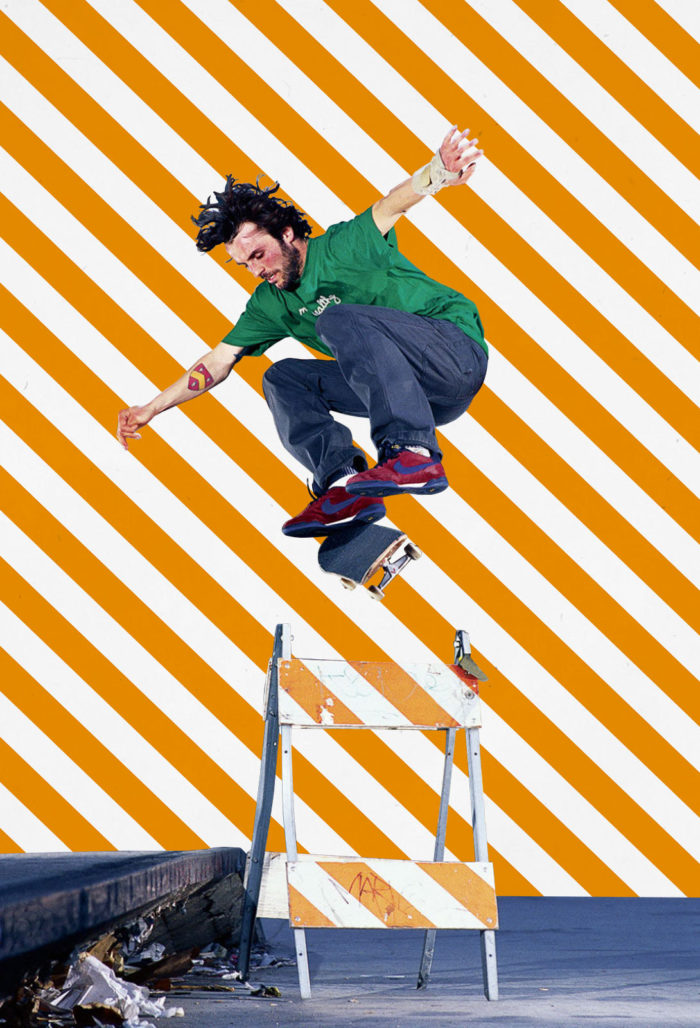
Gino’s switch flip gets the Requiem For A Screen treatment, supplied by the collagist himself
Getting back to Gino, ignoring those FCs, the only thing that I think dates this photo is the size of his board. And if anything, it’s that tiny Venture hanger which puts that into perspective. I’d say it’s a pretty timeless photo but what makes a timeless photo in your eyes?
It goes back to what you said about the person you’re taking a picture of. There’s always some insane trick which is going to stay in peoples’ brains but there are certain people who look good on a skateboard and it translates through a photo. You’re always going to be able to appreciate that. An ollie, for instance, is technically the simplest thing but a good ollie always translates. Same with a kickflip.
Plus, Gino exemplifies ‘less is more’. It’s funny, in his Chrome Ball interview he spoke about worrying that his skating was kind of “basic” compared to what other people were pushing at the time. But here we are talking about this…
Right. That’s the thing. It’s always the basis of it. There’s all this wild technical shit that can be done but everybody’s favourite stuff seems to be a dude going really fast or a big ollie. That’s the shit that stands out at the end of the day.
“We have a little yard in front of my house and I have one of those sawhorses behind the fence because someone left on it the street corner. I was like, “I’m going to take this in case I find a good bump for it…”
On that note, you shot Jason Dill ollieing a trash can out of a little bump, which was in his Mind Field part, and you shot a great switch flip with Dylan Rieder in a similar set-up to this which was in Boys of Summer. Have you got soft spot for kerb-cuts or is it just a coincidence I thought of those…
No, 100%. I love it. I’m always down to shoot them. It’s one those things that doesn’t really get old to me. Do you know what’s funny? We have a little yard in front of my house and I have one of those sawhorses behind the fence because someone left on it the street corner. I was like, “I’m going to take this in case I find a good bump for it…” [Laughs].
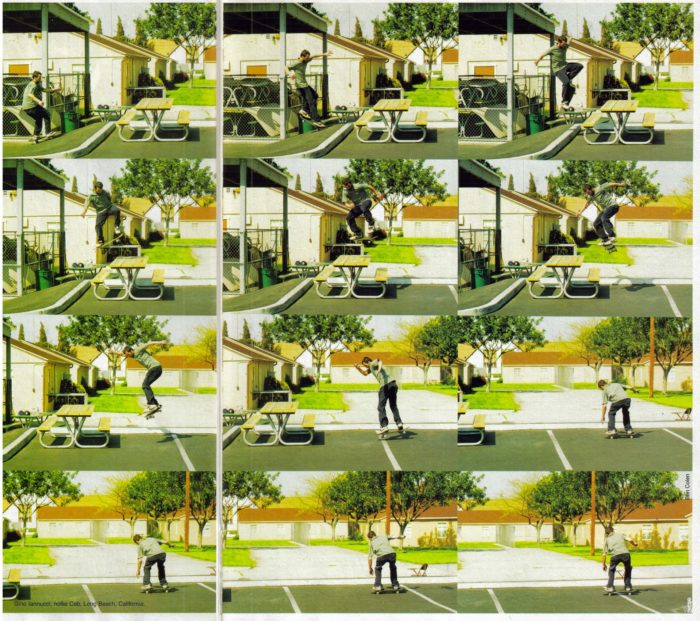 You’ve shot a lot of photos in schoolyards over the years. Including another one of Gino which comes to mind, that bump-to-table nollie 360 which also ran in Skateboarder. When you’re shooting in that blank canvas sort of environment, does it go back to what we were talking about earlier where it’s very much the person that makes it special?
You’ve shot a lot of photos in schoolyards over the years. Including another one of Gino which comes to mind, that bump-to-table nollie 360 which also ran in Skateboarder. When you’re shooting in that blank canvas sort of environment, does it go back to what we were talking about earlier where it’s very much the person that makes it special?
It’s a huge part of it for sure. Especially just because so many of the schoolyards kind of look the same to an outsider. If you haven’t been to all these different schools, then a lot of them could be the same school. It’s the same colours. So, I think the person skating there makes the majority of the difference when you’re shooting a photo of it. Every so often somebody does something over a table which seemed impossible at the time, and that’ll stand out, but for the most part it’s really down to who the photo is of.
What’s your favourite photo of Gino that somebody else has shot?
There’s a switch back tail that O’Meally shot on one those plastic jersey barriers off of a bump in New York. I love that photo. There was a clip of him doing a front nose to fakie on that too so that photo sticks in my head for sure. That one is fucking awesome.
I kind of expected you to say another O’Meally photo, the back three down the double set.
Oh, that’s amazing. I was thinking of a still but that back three is the best, the clip is incredible. The little roll off the curb… That sequence is incredible but just for a still photo, the lighting [on the switch backside tail] and the way he’s standing on it is rad
Actually, there’s a photo that I think Reda shot of him ollieing over a hip on Long Island. I always tripped on that spot when I was a kid. Those things are fucked. It’s a steep bank, it’s a weird angle because of the way you’ve got to ride up to it… Everything about it. That’s another banger. Gino did a bunch of stuff on those and that thing was so fucking hard to skate. All that stuff was like, “Holy shit, this dude just owns this place.”
Coincidentally, Ben’s favourite photos of Gino both of became Chocolate ads. Switch backside tailslide by O’Meally and backside ollie by Reda. Scans courtesy of The Chrome Ball Incident and Science Vs Life, respectively.
If the footage of that switch flip exists, it’s eluded me. And I’ve rinsed a lot of Gino prior to this conversation. Nowadays, anything worth documenting usually gets committed to both footage and a photo but what significance does it add when there isn’t any footage to go with a photo?
It’s funny, now everybody expects that if there’s a photo then where’s the footage? But there was a point where that wasn’t the thought process at all. It was like, “Let’s go shoot a photo,” and if somebody happened to be there to film it, then they’re going to film it. Or, “Hey, I want to go film something,” didn’t necessarily mean you’re going to shoot it too. There are stories too, about people doing stuff that didn’t get documented, which are amazing and that would almost never happen now. Now, it’s like everything has to be hyper-documented but I feel if it leaves you wondering then that can be rad.
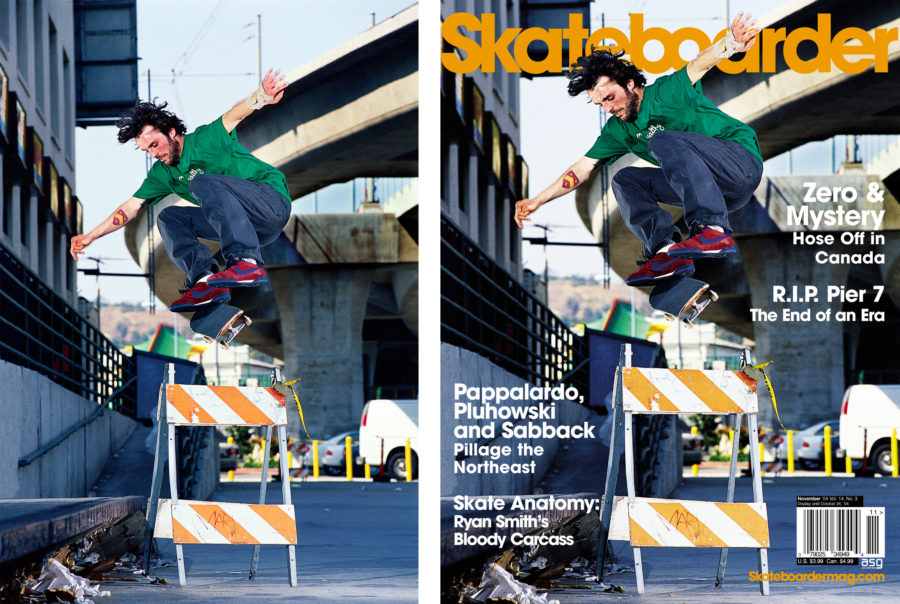
More Gino Iannucci appreciation in our interview with Bobshirt’s Tim Anderson and more from Ben Colen behind the lens in our conversation with Caleb Barnett.
Next in our ‘Lightbox’ series: Karl Watson by Mike Blabac, Jake Johnson by Jonathan Mehring
More photographer stories: Michael Burnett Interview, Benjamin Deberdt: London / Paris / New York, Andrew James Peters Interview, Sam Ashley Interview, Pete Thompson Interview, Eric Dressen at Southbank, Dominic Marley: 5000 Words, Milton Keynes Skate History with Leo Sharp and Wig Worland
Also by Farran Golding: Justin Henry Interview: Doing It From The Home State, Lineage: Tom Knox, Mason Silva Interview: “Basically, everything is wrong with that thing”, Rowan Zorilla Interview: “I hope that’s not my first and last trip”, Andrew Allen Interview: “I’ve always tried to be thankful for the opportunity”, Mark Suciu Interview: “I think it’s very natural to film for a standalone part”


